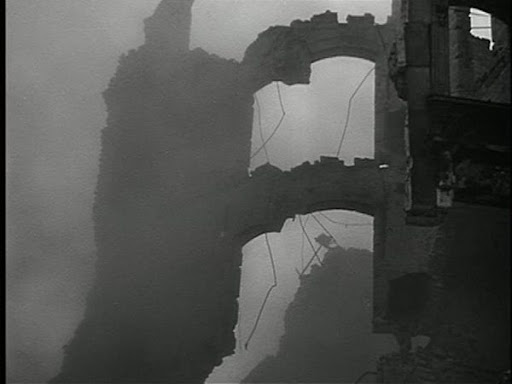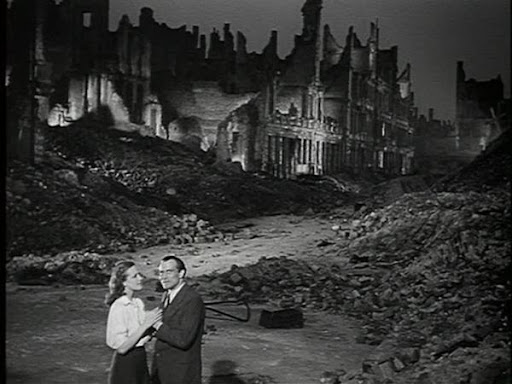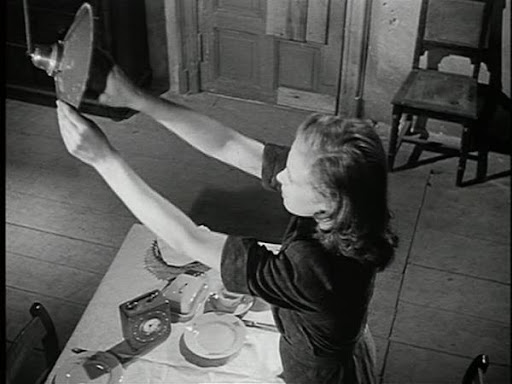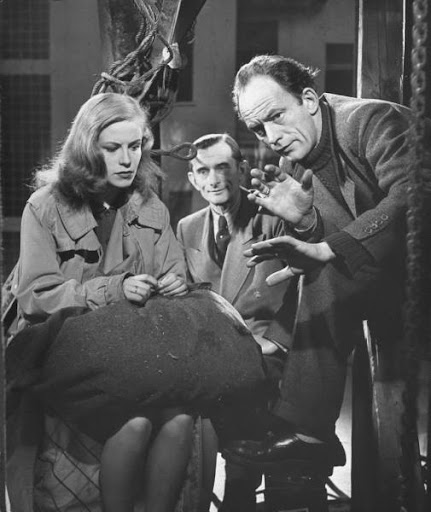
If you've ever wanted to know what it's like to live in post-war East Berlin among bombed-out buildings and a shell-shocked citizenry, then this DEFA East German classic is right up your alley. The Murderers Are Among Us is haunting, in that it was filmed in 1945, right after the war, and one can practically smell the destruction that permeates this film. It's as if the actors are attempting to act something they've experienced, yet the event is so fresh in their minds that it is hard to say if they're acting or simply reliving the horrors of war.
No more philosophizing. It's an amazing film.

From the DEFA Film Library:
The Murderers Are among Us was the first feature film to be produced in Germany after World War II, with script-writing already underway during the final weeks of the war. For this reason, and because many film studios were damaged by bombings, The Murderers Are among Us does not require any documentary footage of the time it depicts. Although there are many scenes in which the landscape of urban rubble serves as backdrop, it is the “inner landscape” of the survivors, especially the traumatized Dr. Mertens, that was most interesting to director Wolfgang Staudte.
At first glance, The Murderers Are among Us appears to have little to do with the issue of German-Jewish relations following World War II. It is striking for instance, that the first German film depiction of a concentration camp survivor is not, as one might assume, clearly of a Jew. The film, rather, remained ambiguous as to why Susanne Wallner was imprisoned by the Nazis. The final film version reveals only that it was “wegen ihres Vaters,” or “because of her father,” whereas the original script indicates that her father was a communist (Shandley 2001, 134). Presumably, viewers are left to question her father’s background. Was he Communist? Jewish? Or both? Other victims of war appear only tangentially, as with Mondschein, a kindly optician who survived the war and eagerly awaits word of his son’s well-being. Mondschein might be Jewish, although there is no explicit reference in that direction. A name such as “Mondschein,” whose literal nature (meaning “moonlight”) was common to Jewish names, might have sufficed at the time to allude to German Jews who survived the war in Berlin in hiding. Indeed it is Mondschein who corrects Susanne when she declares, “It is so difficult to forget [the past]!” “No it isn’t, Fräulein Susanne. It is easy [to forget] if one has a worthy goal.” Another telling allusion to Jewish suffering is depicted in a scene in which Herr Brückner is leisurely reading a newspaper bearing the headline “Two Million Jews Gassed!” It is here that the filmmakers slyly reference Hannah Arendt’s notion of the “banality of evil,” in which evildoers escape our notice because of their often tedious pretenses (Meyers 1997, 76). As the film closes, the war’s victims are represented by images of endless wooden crosses. In this manner, the predominance of Christian symbolism denies the existence and the uniqueness of non-Christian victims. Such imagery also denied audiences the opportunity to explicitly confront the fate of the Jews during the Third Reich. Yet despite the apparent absence of references to Jews and their suffering under the Nazis, The Murderers Are among Us still established the context for later films that would consider such themes.

Where Murderers succeeds is in its generalized commentary, which proved widely significant to the victims and the perpetrators alike. The character of Dr. Mertens, despite having participated in the Nazi regime, responds with horror to the memory of crimes he himself committed and to a society in danger of clearing away its responsibility with its rubble. The character of Susanne Wallner, who had recently returned from an unnamed Nazi concentration camp, also becomes a role model. Wallner, though an innocent victim of the Nazis, heroically maintains her optimism, [socialist] conviction, and capacity for forgiveness throughout the film. Together, the characters inhabit the emotional expanse between optimism and skepticism that many Germans shared.
The Murderers Are among Us self-consciously ignores the film style that had been fashionable during the Nazi period and returns to the genres and styles of the prewar era that had brought Germany international recognition and acclaim. As with antiwar films prior to World War II, The Murderers Are among Us promotes pacifism. Its film noir style, which focuses on dark themes such as melancholy, moral corruption and guilt, is reminiscent of German expressionism, as is its figurative use of light and dark to reflect the characters’ emotions (Meyers 1997, 76-78). The occasional use of extreme camera angles and perspectives, symbolic shadows and bright lights places this film outside the tradition of Nazi melodrama; its theme, however was quite timely, touching the nerve of its audience. Some scholars have even suggested a link between the structure of The Murderers Are among Us and the tradition of movie westerns and gangster films (see Shandley under Related Reading). Moreover, the Lexicon of International Film (1987, Vol. 5, p. 2656) declared, “Staudte’s work is one of the few German rubble films, that is committed to upholding an earnest contestation between guilt and conscience.”

Director Wolfgang Staudte was motivated by personal experiences to begin writing the script while the Nazis were still in power, — a fact that could have cost Staudte his life had his drafts been discovered (Meyers 1997, 74). In 1933, Staudte was banned from performing on stage “because of his association with progressive political theater circles” (Silberman 1995, 101). Ironically, his career was limited to minor roles in propaganda films, such as Veit Harlan’s Jew Suss [Jud Süss, 1940]. Following the war, the Allied forces exercised control over the German media as a means of ensuring that Germans relinquish all ties to Nazism. By that time, Staudte was working steadily in a synchronization studio dubbing Russian films into German. In 1945, he presented his film script for The Murderers Are Among Us to the various occupying forces. The story was rejected by American, British, and French military officials, but accepted by Soviet officials. “[…] I took my script first to the British, then to the Americans and finally to the French. Nobody wanted the material. Peter van Eyck was the Cultural Officer for the Americans and he gave me to understand, in broken German… ‘that we Germans could forget about films for the next twenty years’” (Mückenberger 1999, 60). In a later interview Staudte commented, “only the Russian Cultural Officer [Major Alexander Dymschitz] was interested in my project” (Mückenberger 1999, 60).
Staudte was required to make some changes to his original script, which – describing Dr. Mertens’ intent – was originally entitled The Man I Want to Kill. Major Dymschitz, fearing an outbreak of vigilantism, required Staudte to alter the original ending, in which Dr. Mertens kills his former commander (Pflügl 2001, 163). In the final version, Susanne Wallner prevents this arguably anarchic act, leaving Brückner proclaiming his innocence while comically and monstrously distorted by the camera movement and his off-screen voice.

Prior to the film’s premiere, Ernst Wilhelm Borchert, the actor who played Dr. Mertens, was arrested by the American occupied forces for making false statements regarding his past on an official questionnaire (Mückenberger 1997, 16). As a result, Hildegard Knef, who played Susanne Wallner, is the only person to appear on the promotional posters for The Murderers Are among Us. Mr. Borchert was released in time to attend the film’s debut (Mückenberger 1997, 16). Wolfgang Staudte’s original choice for the role of Dr. Mertens had been Carl Raddatz. Raddatz declined the role because he did want to be involved in a film that, in his opinion, was critical of German soldiers (Meyers 1997, 75). Hildegard Knef, meanwhile, who was plucked from obscurity by Staudte to play Susanne Wallner, was “a product of her time, and with her the war- and the postwar landscape came to the screen: nighttime bombings, fallen cities, hunger, cold, chaos, the black-market. She appeared as the symbol of a defrauded yet not defeated youth” (Meyers 1997, 80).
The Murderers Are among Us was ranked the sixth most important film in the history of German cinema in a survey conducted by Deutsche Kinemathek of Berlin and circulated among film critics, historians, film scientists, and directors. During the immediate postwar years, the film was screened in over twenty-three countries (Film- und Fernsehkunst der DDR, 1979: 90). It was not until almost two years after the making of The Murderers Are among Us that a comparable film regarding the immediate postwar experience was produced in the Western zones: Helmut Käutner’s In jenen Tagen (In Those Days). Coincidentally, positive reviews of the film following its premiere on October 15, 1946, appeared in German newspapers alongside accounts of the executions of Nazis condemned in the Nuremberg trials (Mückenberger 1999, 61). Thus, however unintentional, Germans were doubly reminded of the importance of civil order during such chaotic times.

Technical Information:
Title: Die Mörder sind unter uns/The Murderers Are Among Us
Year: 1946
Country: East Germany
Director: Wolfgang Staudte
Source: DVD5 Retail
DVD Format: NTSC
Container: .iso + mds
Size: 4.08 GB
Length: 1:20:43
Programs used: ImgBurn
Resolution: 720x480
Aspect Ratio: 4:3
Video: MPEG2 @ ~7200 kb/s
Frame Rate: 29.97
Audio: German- Dolby AC3 Stereo @ 224 kb/s
Subtitles: English (hard-coded)
Menu: Yes
Video: Untouched
DVD Extras: Director biography and filmography, liner notes, photo gallery

(Use JDownloader to automate downloading)
The Murderers Are Among Us Megaupload Links



